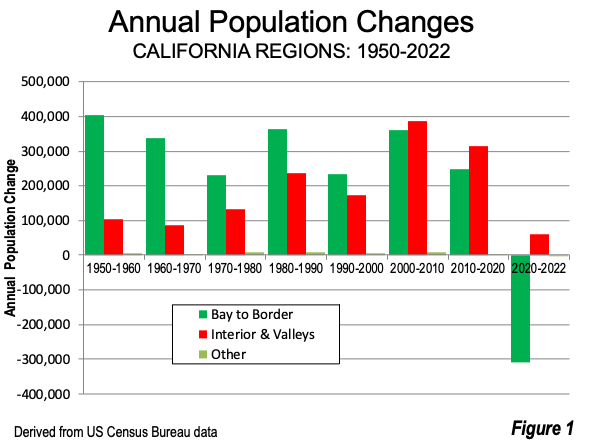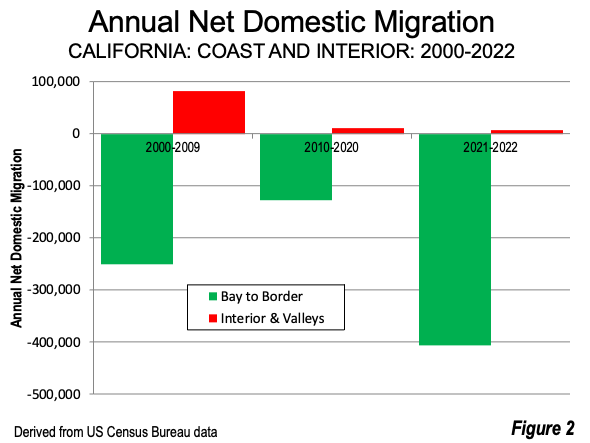
For nearly all the 20th century, California was the national growth leader. In every census from 1930 to 2000, California added more residents than any other state. In 1900, California ranked 21st in population in 1900, but by 1970 secured the top position, which it has occupied since then. But much has changed. US Census Bureau estimates indicate that California’s population has declined three years in a row, after having never reporting a population loss since statehood in 1850s. U.S. Census Bureau data also indicates that there has been a net outflow of residents to other states of 3.5 million since 2000, as housing affordability has deteriorated and the cost of living has become more challenging.
Historically, most of California’s population growth has occurred along the Pacific Coast from Santa Rosa County to the Mexican border (called the “Coast: Bay to Border” in this analysis. This area peaked (post-war) with 79.8% of the state’s population in 1970 and 78.9% of state growth between the 1950 and 1960 censuses. By the 1990-2000 period, the share of state growth in this area had fallen to 57.1%.
This shift began in the 1970s as people began migration to what is referred to as the “Interior & Valleys,” which includes the counties between the Coast ranges on the west and the Sierra and Cascade ranges in the east. This includes the Sacramento and San Joaquin Valleys as well as San Bernardino, Riverside and Imperial Counties. This area includes two of the state’s six major metropolitan areas, Sacramento and Fresno.
In 1970, the Interior & Valleys accounted for 21.3% of the population, having added 20.1% of the California’s population growth between the 1960 and 1970 censuses. By 2000, the Interior Valleys had 28.1% of the population, but had more than doubled their 10-year growth share (1990-2000) to 41.2%.
During the 2000s, the Interior & Valleys, for the first time (post-war), accounted for a majority of the state’s population growth (51.3%). This increased to 55.6% in the next decade. In the first two years of the 2020s, the Interior & Valleys grew by 120,000 residents, while the Bay to Border lost 621,000 residents even as the state lost 509,000 during this period. Figure 1 illustrates these figures annualized.

Within the last decade, and in response to the much faster population growth of the San Joaquin Valley (in the Interior Valleys), the US Office of Management and Budget added counties with a strong commuting relationship with other Bay Area counties to the San Jose-San Francisco combined statistical area. These include San Joaquin County, Stanislaus County and Merced County, which remarkably has a border with Fresno County, near the middle of the Valley.
Coincidentally, in the peak year of Coastal population share (1970) all of the major housing markets in the state (the Los Angeles, San Francisco, San Diego, Sacramento, San Jose and Fresno metropolitan areas) retained strong housing affordability, with median house prices under 3.0 times the median household income.
Since 2000, the state has lost 3.5 million net domestic migrants (people who move from one county to another) to other states. This is equal to 8.9% of the state’s 2022 population. The largest losses have occurred in markets with the most severe housing affordability. The Bay to Border lost net domestic migrants equal to 16.9% of their 2022 population, while the Interior & Valleys gained 6.7%. The other areas of the state — mostly lower populated areas in the North and to the east of the Sierras — lost net domestic migrants equal to 1.6% of their 2022 population.
Among the larger counties, the greatest net domestic migration losses relative to their 2022 population were Santa Clara, at minus 26.6%, San Mateo, at minus 23.3%, Los Angeles, at 22.9%, and San Francisco, at 22.0%.
In contrast, the counties of the Interior &Valley counties enjoyed strong net domestic migration between 2000 and 2009, at 734,000. But this dropped to 114,000 in between 2010 and 2020, an annual average of 11,400. In the first two years of this decade, annual net domestic migration dropped to a mere 7,000. This drop in net domestic migration corresponds with rapidly deteriorating housing affordability during the period (Figure 2).

Finally, the State Department of Finance 2060 population estimates anticipate further dominance by the Interior & Valleys. The projection was made before the population losses had been reported, and the next set of projections will take into consideration later trends. However, the Bay and Border population is projected to grow by 1.8 million from 2022 to 2060. The Interior & Valleys population is expected to grow nearly twice as much, at 3.4 million. The other parts of the state are projected to lose about 40,000 residents. In 2060, the Interior & Valleys share of the state population would reach 37.1%, up 85% from the 1970 share of 20.1%.
The changing dynamics of California population growth has caught the state government by surprise. As late as 2007, the Department of Finance was projecting a 2050 population of 60 million. The most recent projections call for 44.2 million residents, ten years later (2060). To the extent that California has growth potential, most of it is expected to occur in the Interior & Valleys. The days of the great coastal boom are over, and with it, an epoch in American demographics has come to an end. Go west has gone to the east, at least in California and perhaps some other states as well.
Wendell Cox is principal of Demographia, an international public policy firm located in the St. Louis metropolitan area. He is a founding senior fellow at the Urban Reform Institute, Houston, a Senior Fellow with the Frontier Centre for Public Policy in Winnipeg and a member of the Advisory Board of the Center for Demographics and Policy at Chapman University in Orange, California. He has served as a visiting professor at the Conservatoire National des Arts et Metiers in Paris. His principal interests are economics, poverty alleviation, demographics, urban policy and transport. He is co-author of the annual Demographia International Housing Affordability Survey and author of Demographia World Urban Areas.
Mayor Tom Bradley appointed him to three terms on the Los Angeles County Transportation Commission (1977-1985) and Speaker of the House Newt Gingrich appointed him to the Amtrak Reform Council, to complete the unexpired term of New Jersey Governor Christine Todd Whitman (1999-2002). He is author of War on the Dream: How Anti-Sprawl Policy Threatens the Quality of Life and Toward More Prosperous Cities: A Framing Essay on Urban Areas, Transport, Planning and the Dimensions of Sustainability.
Photo: Fresno City Hall by ‘Model Citizen’ via Wikimedia under CC 3.0 License.












